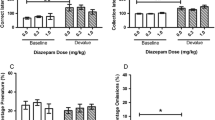Abstract
An often used animal model based on the effects of neuroleptics on spontaneous behaviour is the catalepsy test. However, this test seems to be particularly insensitive to the atypical neuroleptics thioridazine and, especially, clozapine. We have therefore developed an alternative test, the paw test, which measures the ability of drugs to prevent the spontaneous withdrawal of fore- and hindlimbs in rats, and have compared this with the classical catalepsy test. The results show that: 1) the classical neuroleptic drugs haloperidol and chlorpromazine, the atypical neuroleptic drugs clozapine and thioridazine, the potential atypical neuroleptic drugs molindone and SCH 23390, and the potential classical neuroleptic drug metoclopramide are potent in increasing the hindlimb retraction time; 2) the paw test discriminates between classical neuroleptics which are equipotent in prolonging both the forelimb (FRT) and hindlimb retraction time (HRT) and atypical neuroleptics which are much more potent in prolonging HRT than in prolonging FRT; 3) the non-neuroleptic drugs desipramine, diazepam and morphine do not influence the variables measured in the paw test, although morphine does produce catalepsy; 4) Molindone as well as SCH 23390 behave like atypical neuroleptic drugs in the paw test. In comparison with the classical wood block catalepsy test, the paw test is shown to be superior for predicting the profile of the neuroleptics tested. Although more neuroleptics and non-neuroleptics have to be tested to determine whether false positives and false negatives do occur, we feel that the paw test might be an interesting animal model, because the increase in hindlimb retraction time was associated with the antipsychotic potential, whereas the increase in forelimb retraction time was associated with the potential to induce so-called extrapyramidal side effects.
Similar content being viewed by others
References
Arnt J (1983) Neuroleptic inhibition of 6, 7-ADTN-induced hyperactivity after injection into the nucleus accumbens. Specificity and comparison with other models. Eur J Pharmacol 90:47–55
Carlton P, Manowitz P (1984) Dopamine and schizophrenia: An analysis of the theory. Neurosci Biobehav Rev 8:137–151
Chiodo L, Bunney B (1983) Typical and atypical neuroleptics: Differential effects of chronic administration on the activity of A9 and A10 midbrain dopaminergic neurons. J Neurosci 3:1607–1619
Cools A (1983) Mesolimbic system and tardive dyskinesia: New perspectives for therapy. Mod Probl Pharmacopsychiatry 21:111–123
Davis A, Jenner P, Marsden CD (1986) A comparison of motor behaviour in groups of rats distinguished by their climbing response to apomorphine. Br J Pharmacol 87:129–137
DeRijck M, Teitelbaum P (1983) Morphine versus haloperidol catalepsy in the rat: An electromyographic analysis of postural support mechanisms. Exp Neurol 79:54–76
Ellenbroek B, Schwarz M, Sontag K, Jaspers R, Cools A (1985) Muscular rigidity and delineation of a dopamine-specific subregion: tonic EMG activity in rats. Brain Res 345:132–140
Koehler C, Haglund L, Ogren S, Angeby T (1981) Regional blockade by neuroleptic drugs of in vivo 3H-spiperone binding in the rat brain. Relations to blockade of apomorphine induced hyperactivities and stereotypies. J Neural Transm 52:163–173
Lane R, Blaha C (1986) Electrochemistry in vivo: Application to CNS pharmacology. Ann NY Acad Sci 473:50–69
Lavy S, Melamed E, Penchas S (1978) Tardive dyskinesia associated with metoclopramide. Br Med J [Clin Res]: 1:77–78
Ljungberg T, Ungerstedt U (1985) A rapid and simple behavioural screening method for simultaneous assessment of limbic and striatal blocking effects of neuroleptic drugs. Pharmacol Biochem Behav 23:479–485
Schwarz M, Turski L, Sonntag K (1983) Reversal of the muscle relaxant effect of diazepam but not of progabide by a specific benzodiazepine antagonist: Ro 15–1788. Eur J Pharmacol 90:139–142
Siegel S (1956) Nonparametric statistics for the behavioural sciences. McGraw Hill Kogakusha, Tokyo
Stanley M, Lautin A, Rotrosen J, Gershon S, Kleinberg D (1980) Metoclopramide: Antipsychotic efficacy of a drug lacking potency in receptor models. Psychopharmacology 71:219–225
Vrijmoed-de Vries M, Toenissen H, Cools A (1987) The relationship between hindlimb disturbances, forelimb disturbances and catalepsy after increasing doses of muscimol injected into the striatal-pallidal complex. Psychopharmacology 92:73–77
Wand P, Kuschinsky K, Sonntag K-H (1973) Morphine-induced muscular rigidity in rats. Eur J Pharmacol 24:189–193
White F, Wang R (1980) Differential effects of classical and atypical antipsychotic drugs on A9 and A10 dopamine neurons. Science 211:1054–1056
Author information
Authors and Affiliations
Rights and permissions
About this article
Cite this article
Ellenbroek, B.A., Peeters, B.W., Honig, W.M. et al. The paw test: a behavioural paradigm for differentiating between classical and atypical neuroleptic drugs. Psychopharmacology 93, 343–348 (1987). https://doi.org/10.1007/BF00187254
Received:
Revised:
Issue Date:
DOI: https://doi.org/10.1007/BF00187254




